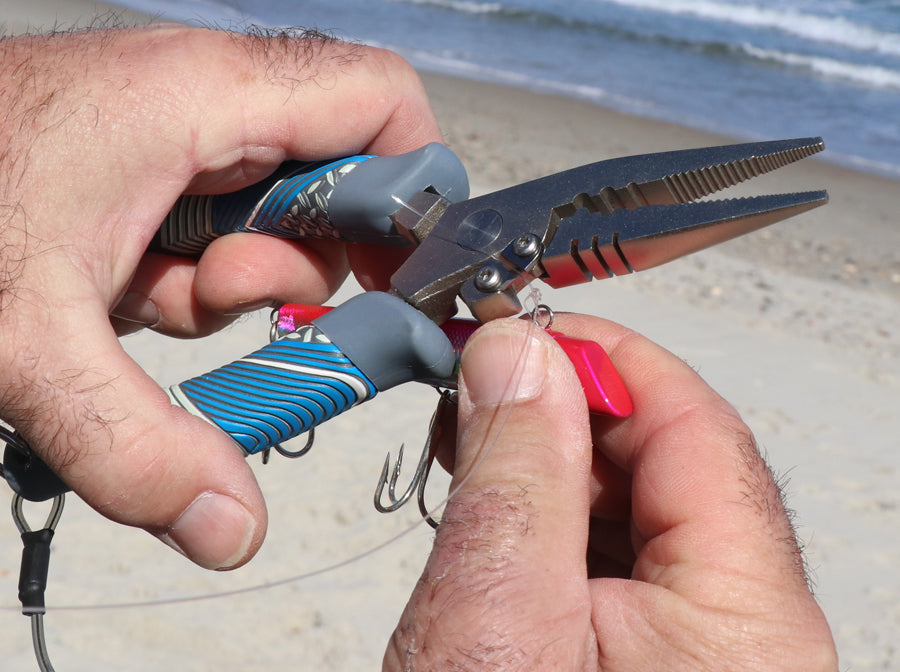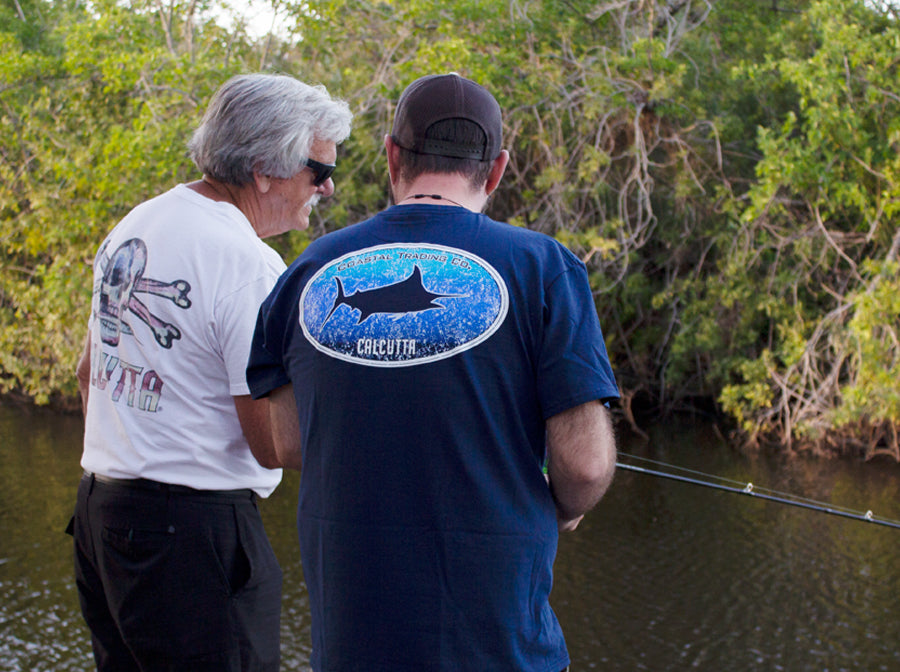The water was roiling with feeding fish as we eased our boat into position. Armed with light spinning tackle and Got-Cha plugs, we were ready for action. Before Captain Noah gave the signal to cast, he reminded us to reel fast—as if our lives depended on it. Then, with a word, the Spanish mackerel bite was on.
There are few saltwater fish more exciting and fun to catch than Spanish mackerel. Casting into a school of feeding Spanish mackerel with light tackle can lead to heart-pumping, line-stripping excitement. Armed with the right tackle and knowledge, anglers can consistently fill their coolers with this tasty fish.
How do you fish for Spanish mackerel from a boat? How do you catch them from the shore? What are the best artificial lures and live baits to use for Spanish mackerel? Which rod and reel setup works best? How do you prepare and cook Spanish mackerel?
We asked Captain Noah Lynk, founder and operator of Noah’s Ark Fishing Charters on Harker’s Island in North Carolina, to share some tips for catching Spanish mackerel. The legendary Calcutta Outdoors Fishing Pro has successfully guided inshore and nearshore charters for more than 20 years. Captain Noah is renowned for consistently putting his clients on fish. Here are the insights, techniques and proven tricks that he shared.

For over 20 years, Captain Noah Lynk has put anglers on Spanish mackerel.
How does Spanish mackerel rank among your favorite fish to catch?
When spring arrives each year, everyone is pumped up for the first run of big Spanish—and I’m right with them. I personally love casting to Spanish with light/ultralight spinning tackle as this is the most exciting way I believe that they can be caught. These speed demons rank right there with Atlantic bonito and false albacore for a pure adrenaline rush.
Are Spanish mackerel good to eat?
Spanish mackerel are absolutely good table fare. Most people like them either fried, grilled or broiled. When grilling Spanish mackerel, use tin foil because they will stick to the grill if you don’t.
What is your favorite way to prepare and cook Spanish mackerel?
I absolutely love fried Spanish mackerel! I use House Autry Seafood Breader and olive oil. It’s simple and extremely good!

Delicious Spanish mackerel can be fried, grilled or broiled.
Where are the best places to catch Spanish mackerel? Does that change with the seasons?
The best places to catch Spanish mackerel are going to be areas with some kind of structure or places where bait fish are going to school up. This includes wrecks, jetties, shoal areas, fishing piers and areas that have live bottom. These places tend to always attract bait fish season after season, so when the Spanish mackerel are running, I can usually find them there. They seem to inhabit and feed in the same areas regardless of the season.
What do you look for when you’re fishing for Spanish?
When I’m headed out for Spanish mackerel, I know within a 15-mile area where the best places are going to be, but I’m also looking for fishing birds that are actively feeding on the surface. This always indicates predator fish feeding on bait as the birds are picking up the scraps. Also, be on the lookout for other boats, especially charter boats, that will be trolling in a circle or staged up on a large school and casting to them. Tide can also play a big part in their feeding cycle, so don’t give up on an area that has been productive if the tide or winds aren’t the same as when you’ve caught them before.
What’s the best way to catch Spanish mackerel from a boat? Trolling, casting, jigging?
There is no best way to catch them from a boat as all three methods work just as good, albeit they usually work at different times or one method may be more preferable to you than the other.
As with any serious fishing, the first thing you’ll need to do is be prepared with all the tackle that you may need. I always start the season stocking up one of my Calcutta tackle bags with just Spanish mackerel tackle for trolling, casting and jigging as you never know what you’ll need and when you’ll need it—but I can guarantee you will need it. I pack my tackle bag with extra Sea Striker planers (#1, #2 and #3) and extra hooks. I definitely pack extra Sea Striker Got-Cha plugs of different sizes and colors, Clarkspoons, Sea Striker jig fish lures in all sizes. You also need to have pre-rigged leaders, which I make up ahead of time. I rig these leaders with top-of-the-line BillFisher terminal tackle (swivels, snap swivels, etc.), which I keep organized by wrapping them on Sea Striker leader wheels so they’re ready to roll whenever I need them.

Trolling is probably the most popular method of catching Spanish mackerel as it’s the easiest to do. To start with, always troll at six to six and a half knots or so. Spanish mackerel like it fast. When trolling, most people are going to use something like a Shimano TLD or a Penn Senator or something equivalent spooled with 20/30 lb. test rigged with a #2 or #3 Sea Striker planer with a Clarkspoon or Drone Spoon. You can also use the tried and trusted hand lines, in which case, you usually pull a #1 or #2 Sea Striker planer, or both with one on each side and the lures at different depths in the water column.
Casting for Spanish mackerel is definitely the most fun and exciting way for fisherman to catch these speedy fish in my opinion. This is an entirely different approach from trolling. When casting for Spanish, you’re going to need to be in a fairly sizable school of aggressively feeding fish that are just tearing up the water. To find these schools, you’re once again going to need to find the big flocks of birds feeding or spot other boats staged up on feeding fish. When approaching a school of these fish, they can be really boat shy, so don’t come flying in or run through the school as this will break them up and send them deep. Approach at a very slow speed and come to a stop approximately 20 yards off the school. This is where the right tackle comes in. I’m usually throwing the metal Sea Striker jig fish in the 1/2 oz. or larger and also the ever-popular Got-Cha plug in different colors and sizes. When casting, make a good solid cast over the school or around the edges and have a really fast retrieve. Remember trolling speed is 6 knots, so you gotta match the speed. You’re definitely going to need a really good leader. I always use 30 lb. BillFisher leader up to the lure because a good leader can take some nicks and scratches from these toothy fish. Speaking of toothy fish, I always have my Calcutta Squall pliers hooked to my side. You’ll definitely need good pliers to dehook a nice Spanish and keep your fingers clear of the teeth.
Jigging for Spanish usually occurs when these fish go deep but are still feeding. For this situation, I usually turn to the trusty Sea Striker jig fish in 3/4 oz. and heavier. You’ll want to jig with a high-speed jigging action, working the bait up and down. To find the depth of the school, use your fish finder. This is a pretty straight forward approach. If the fish quit biting, move around until you locate the school again as they’re always moving, following schools of bait fish.

The right gear and tactics will help you catch more Spanish mackerel.
How do you fish for Spanish from the shore?
Fishing for Spanish mackerel from shore means that you are constrained by your surroundings. This might be a nice beach, a rock jetty, or a fishing pier you’re fishing from, so you have to be acquainted with your surroundings and know your limits. Usually a school of feeding fish busting the water can be seen moving toward you from one direction or the other. This is where having several rods rigged up makes the difference. Usually, casting from a fixed location to a school of feeding Spanish mackerel is best accomplished using Got-Cha plugs of various sizes and colors. This is where you want to have several rods rigged up due to either getting cut off or they’re just not hitting one color vs. another. Rigging several rods will definitely increase your catch ratio as you can replace one very quickly instead of having to tie on another lure.
What are the best live baits for Spanish mackerel?
The best live baits for catching trophy Spanish mackerel are going to be menhaden, herring, mullet and sardines. This pretty much goes for the entire East Coast. Other species can be used as live bait, but these appear to work the best.
What are your favorite fishing lures for Spanish? How do you fish them?
I use small lures when casting, trolling or jigging for Spanish mackerel because they prefer small baits. I often find Spanish mackerel feeding on bay anchovies, glass minnows (silver sides), sardines or finger mullet. They’re usually in large schools. The only time I’m not using small baits is when live baiting. My favorite lures for catching Spanish mackerel are the Got-Cha plug, Sea Striker jig fish and weighted Clarkspoon for casting. Remember when casting to Spanish mackerel that you have to keep up a high rate of retrieval. If you don’t, they’ll follow your lure, but won’t hit it very often. For trolling, the first and most important thing to remember is that your speed needs to be at or just over six knots. I’m almost always going to be using a Clarkspoon or Drone Spoon of the appropriate size to match the bait they’re feeding on.

A fast retrieve is key when casting for Spanish mackerel.
When you’re trolling and start to make a turn, make it extremely wide as you’re usually trolling at least two lines, maybe more. If your turn is too sharp, your lines are going to be tangled up with each other so make very wide turns. When jigging for Spanish mackerel, your depth of water, current, etc. is going to have a direct effect on how heavy your jig needs to be. I start with the Sea Striker jig fish, Stingsilver lures and Got-Cha plugs. Just about any shiny or brightly colored jig will do the job. Remember that when jigging for these fast-feeding fish, you have to jig fast. Also, be ready to pick up and move with the fish as they’re constantly following the schools of bait fish.
When I’m presented with a situation where I could do all three, say there’s plenty of mackerel where I’m at and it’s my choice how to catch them, that’s where tackle organization comes in. With my Calcutta tackle bag with four tackle containers and other storage areas, I’ve got plenty of room for all the tackle I might need for any given situation that may arise. Also, having plenty of rods rigged pre-departure from the dock can make your day. When Spanish mackerel are in a feeding frenzy, it usually doesn’t last long, so you have to act fast. Having rods already rigged means you don’t have to panic at the sight of feeding fish. Just grab your rod of choice and start fishing.
Which rod and reel setup works best for Spanish mackerel?
I personally prefer light tackle and casting, so my favorite setup is going to be a Star Rods VPR 6-14# with a 3000 series spinning reel. It’s plenty good on the light action side, but still has plenty of backbone (stiffness) to hold any Spanish mackerel I catch. I’ll use the same setup for jigging them as well. My favorite trolling rod when using a conventional setup is the Star Rods Plasma boat rod in medium/light action with a Shimano TLD 25 lever drag or a reel comparable to this. You really don’t need heavy gear to catch Spanish mackerel as it’s overkill and much more enjoyable to catch them on lighter tackle.

Trolling is one of the most effective and popular ways to catch Spanish mackerel.
What is your biggest secret to catching Spanish Mackerel?
There is no real secret to catching Spanish mackerel, but the biggest thing is in your preparation. Know your area, where bait fish usually school up. Know your local wrecks, rock jetties, structure etc. Know the local tides, winds and the preferences of Spanish mackerel. Are they feeding at dawn? Or are they feeding best once the sun gets overhead? Or are they feeding best on or around a certain tide change? This is information that you’re going to need to know to be successful and, in my opinion, is the biggest secret to success. In the end, nothing can make up for time spent on the water. Information is king.
Any additional fishing tips you would offer?
I do a lot of speaking to groups on all kinds of fishing. Here are the basic things I tell them when starting out fishing for any certain species. If you’re brand new to fishing for what you’re after, it’s probably in your best interest to get a local guide to show you the ropes a few times. This can save years of frustration trying to figure things out on your own.
Join local fishing clubs that cater to your fishing needs as local information is invaluable and chances are you’ll get invited on a fishing trip or two. You will be able to start to see how things are done, when to go out, when not to go out, what tackle to use in certain situations, etc.
If you’re intent on using your own boat and heading out for Spanish mackerel, when you find the fish, watch how the boats around you are fishing. Are they trolling? If so, what pattern are they in? Don’t troll against the pattern. Are they casting? If so, it’s probably not the best place to troll for them. Basically, use common sense and good courtesy. It will take you far when out on the water.
Go Fishing with Noah’s Ark Charters
Want to experience the fun and excitement of Spanish mackerel fishing? Book a charter trip with Captain Noah Lynk at NoahsArkFishingCharters.com.
More Resources
Essential Fishing Tools for Your Tackle Box
Strategies to Optimize Your Fishing Tackle Storage
Fishing Boat Checklist: 11 Steps to Prepare for Fishing Season
Pre-Season Study: 6 Tips to Improve Your Fishing IQ
7 Tips to Prep Your Fishing Gear for the Spring Season



